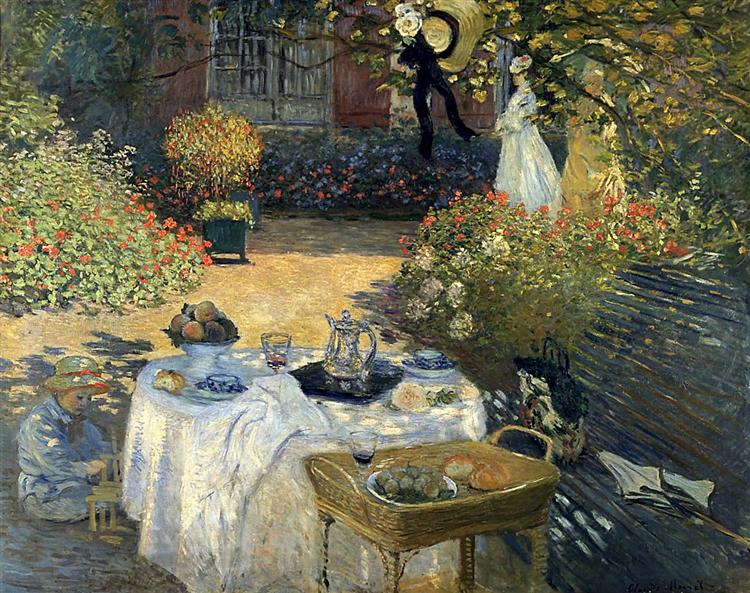描述
In “The Luncheon” from 1873, Claude Monet captures a moment of everyday life with a freshness that characterizes his work, and at the same time becomes a visual document of the social intimacy of his time. As part of the Impressionist movement, Monet moves away from academic formalisms, choosing instead to depict light, color, and life in their purest state, often reflecting a sense of immediacy and spontaneity. The work, which portrays a group of friends enjoying lunch outdoors, reflects the social life of the Parisian bourgeoisie in a relaxed setting.
The composition of the painting is notable for its arrangement, which creates an aura of warmth and closeness. The figures are grouped around a table decorated with a striped blanket, suggesting a picnic in a natural setting. The bodies are positioned in such a way that the viewer's gaze flows naturally between them, creating a sense of community and connection. Monet allows himself to play with the space of the painting: the figures are barely defined, suggesting rather than showing, which in turn adds to the air of informality that permeates the whole.
The colours used by Monet in this work are bright and vibrant, encapsulating the daylight and the texture of the surroundings. Green tones predominate, evoking summer and the surrounding nature; the touches of blue and red in the characters' clothing bring contrast and vitality to the scene. The colour palette, however, does not seek fidelity to realistic colour, but rather emotional evocation. The technique of loose and rapid brushstrokes contributes to the atmosphere of fluidity, as shadows and lights seem to move gently, almost as if the viewer could feel the countryside breeze.
As for the characters, the work includes three recognizable figures from the artist's life. The woman in the center, wearing a white dress, is Camille Monet, Claude Monet's wife, who appears frequently in the painter's work. At her side, a bearded man, leaning towards her, is Frédéric Bazille, a friend and colleague of Monet who also belonged to the Impressionist circle. The interaction between the characters, although not dramatized, suggests a pleasant conversation, a moment of complicity and relaxation that seems to be suspended in time.
Monet, like his contemporaries, is committed to the idea of depicting reality in both its aesthetic and emotional sense. The Luncheon can be seen as an echo of the Impressionist quest to represent the world more subjectively, focusing not only on what is seen, but on what is felt at that particular moment. This approach is evident in similar works by Monet and other Impressionists, where light plays a fundamental role in defining the atmosphere and mood.
The work is also an example of Monet's appreciation for nature, which is not limited to a visual background but is an integral part of the experience of the moment. The inclusion of vegetation and natural elements underlines a sense of harmony between man and his environment, something that resonates deeply in the Impressionist aesthetic.
“The Luncheon” is ultimately a testament to Monet’s vision of life and human interaction in his environment. In his depiction of time, color, and light, Monet creates a space where everyday life becomes art, underlining that the ordinary can become extraordinary in the hands of a master. This work not only represents a moment in time but also a bridge to the search for beauty in the simplicity of daily life, a legacy that has endured in the art world to this day.
KUADROS ©, a famous painting on your wall.
Hand-made oil painting reproductions, with the quality of professional artists and the distinctive seal of KUADROS ©.
Painting reproduction service with satisfaction guarantee. If you are not completely satisfied with the replica of your painting, we will refund 100% of your money.

